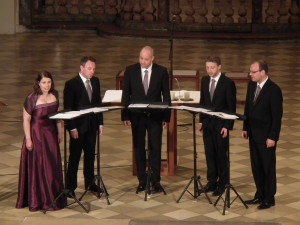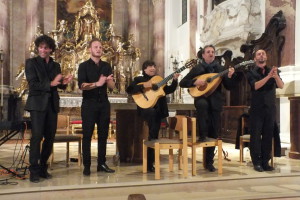By Sebastian Pflüger, Manager of Musica Sacra International
It was for the twelfth time that Musica Sacra International, the musical encounter of the great world religions, took place in Marktoberdorf and the surrounding area of the Allgäu in southern Germany. In this celebratory 25th year of the Marktoberdorf Whitsun Festival, the founder and spiritual father of which, Dolf Rabus, died last year, musicians from the great religions came together to meet under the aegis of music. It was the first festival without Dolf Rabus, but we were reminded of him frequently, especially right at the outset in a moving memorial at the opening concert in the Bavarian Music Academy Marktoberdorf. The Calmus Ensemble from Leipzig sang excerpts from the motet “Jesu, meine Freude” by Johann Sebastian Bach, with pictures from the life of Dolf Rabus reminding us of him in the candle-lit hall.
The Bavarian Music Academy Marktoberdorf, of which Dolf Rabus was the founding director and leader for many years, served as one of the principal venues of the festival. It was here that important concerts and a large proportion of the accompanying lectures and workshops took place, and it was also here that the musicians – instrumental players and singers – gathered for meals and for bringing the day to a close together after the evening concerts.
Calmus Ensemble, Leipzig, Germany
This year eleven ensembles from seven nations and five religions had accepted the invitation from the Federal Association of German Choral Groupings, responsible for Musica Sacra International, to Marktoberdorf. In about twenty-five performances, they helped each other and their audiences towards a better understanding of their musical traditions and their religions. These experiences ranged from various aspects of Christian music, the part-singing of the Georgian-Orthodox tradition, Jewish music of the synagogues and their cantors, Muslim music from the traditions of the North African Sufis, music and Kathak dance from North India as well as prayers and chants from Tibetan Buddhism. For the renowned Calmus Ensemble from Leipzig it was already their second visit to Marktoberdorf. Cappella de la Torre, also from Germany, an ensemble specializing in historical performance practice, presented music played on occasion of the wedding of Martin Luther and Katharina von Bora. “Oche, Bassu, Contra and Mesu Oche” are the names given to the voice ranges of the ancient form of “Coro” brought along by the male quartet Tenores di Bitti Remunnu ‘e Locu from the Mediterranean island of Sardinia. The Ensemble Chants Sacrés Gitans en Provence introduced us – in a very lively manner, though also at times deeply melancholic – to sacred songs from the tradition of the travellers of southern France and northern Spain. The Fayha Chor under Barkev Taslakian from Lebanon unites female and male singers from all religions and social strata of its country, proving in an impressive way that this can be done successfully despite all the political and sociological problems in their home country. The singers of the Iberisi Choir, all of them young Georgians resident in Munich, consider it their mission to make Georgian part-singing, acknowledged as a World Cultural Heritage, well known outside their home country. Jewish music was brought to Musica Sacra International by the choir of the Leipzig Synagogue as well as by [female] cantor Mimi Sheffer, accompanied by Mirlan Kaymaliev. Islam was represented in the Allgäu by the Ensemble Rouh from the Moroccan town of Meknes, performing music of the Sufi brotherhoods of the Gnawa and Aissaoua. The monks from the Tibetan monastery Rabten Choeling from above Lake Geneva in Switzerland shared their chants and prayer rituals with the visitors. Subrata Manna, Supratik Sengupta and Sudokshina Manna Chatterjee from Calcutta introduced us to the ancient Hindu musical tradition of northern India, while the dancer Sohini Debnath narrated stories from – among others – the lives of the gods Shiva and Vishnu in her Kathak dances.
Chants Sacrés Gitans en Provence, France
Musica Sacra International pursues two great goals: it wishes to enable encounters among the musicians of all religions to take place, so they can come to know and learn from each other, and it aims to encourage the people of the Allgäu and far beyond that region to confront other religions and cultures and thus also to reflect more on their own religion. “The more I know about the other, the more openly I can approach him” – that was the creed of Dolf Rabus. In this spirit Musica Sacra International wants to make a small contribution to more mutual respect and tolerance and to a more peaceful world. In order to make a start on this even with young people, the festival organised special schools programmes under the title of “Tolerance is Catching”. Using selected films, live performances by the participating ensembles and discussions, young people from all types of schools were introduced to the religions.
An important aspect of the festival consists of the fact that all the musicians stay in Marktoberdorf for the full duration of the event. Thus, albeit only for a few days, an inter-religious community is created, allowing really deep encounters to take place among all. Every concert in the churches and halls, mosques and synagogues contains contributions from more than one ensemble, wherever possible from different religions.
The idea of Musica Sacra International has already borne fruit, for a number of years, in other places. Immediately after the festival in Marktoberdorf, Musica Sacra International goes touring with some of the ensembles. This year, joint concerts by the ensembles from India, Morocco, France and Lebanon took place in the German federal state of Rhineland-Palatinate within their festival “Cultural Summer Rhineland Palatinate”, in the Netherlands (opening concert of the first choral festival CantaRode Kerkrade) and in Belgium (Festival Musica Sacra in Chimay). However, even that is not all: some organisers of festivals allowed themselves to be inspired by Marktoberdorf to create their own events. Thus in November 2012 the first Festival Musica Sacra en San Juan, Argentina, took place, and the Sacrées Journées in Strasburg, France, founded in 2011, ran for the third time in 2014.
The patron of this year’s Musica Sacra International, the Reverend Dr Olav Fykse Tveit, General Secretary of the Ecumenical Council of Churches in Geneva, described Musica Sacra International and its offerings of the musical riches of many faith traditions as “a sign of hope in an unquiet world. Moreover, it opens the door to an experience of joy, because this is to be found at the heart of music-making. Joy cannot be coerced or produced artificially: space must be available so it can be visited by the spirit of joy. Then, when we can be glad together, united by the beauty of the music and the joy of a performance experienced together, something happens. Our hearts are touched by a heavenly fire”. Developments in our time in many countries of the world show us the enduring importance of little signs like those set by Musica Sacra International.
Translated from the German by Irene Auerbach, UK



